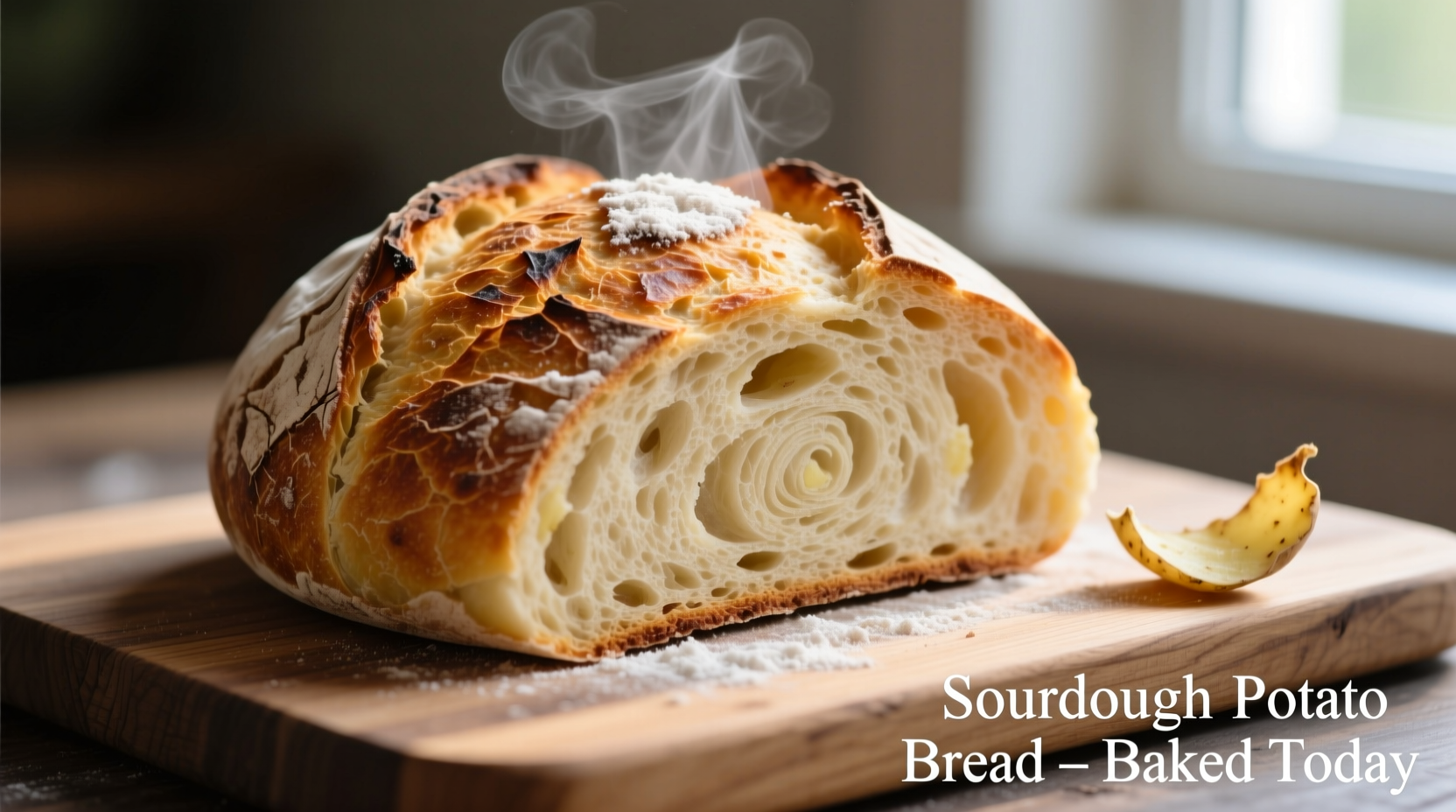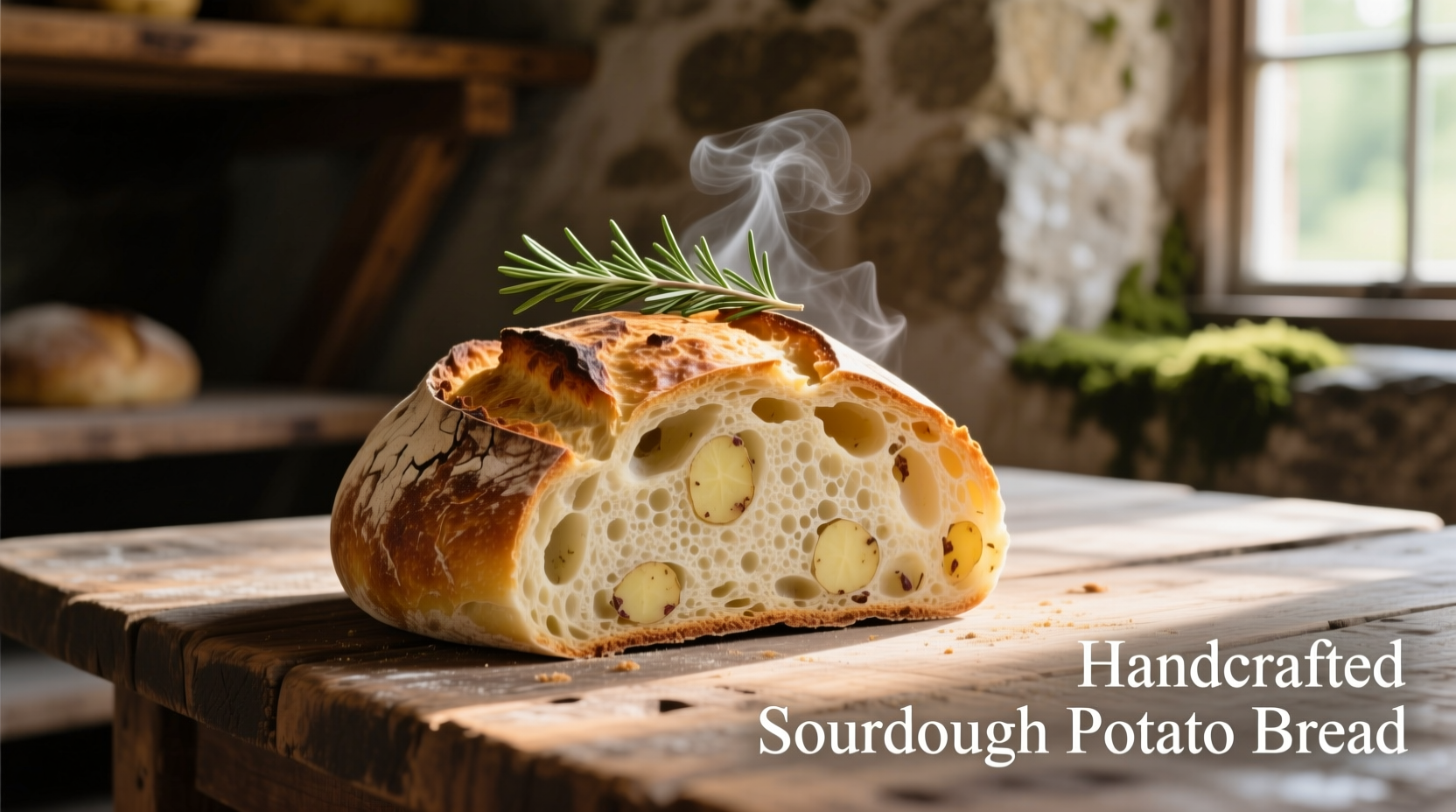Why Potato Transforms Your Sourdough Experience
When you incorporate potato into sourdough bread, you're not just adding another ingredient—you're activating a scientific transformation. Potato contains natural starches and sugars that feed your sourdough culture more effectively than flour alone. The potato's moisture-binding properties create a bread that stays fresh 2-3 days longer than standard sourdough, while the natural sugars promote exceptional browning and crust development.
Professional bakers have discovered that the enzymes in potato break down complex starches into simpler sugars, providing sustained food for your starter throughout the long fermentation process. This results in more consistent rise and a complex flavor profile that balances the characteristic sourdough tang with subtle sweetness.
| Characteristic | Sourdough Potato Bread | Traditional Sourdough |
|---|---|---|
| Shelf Life | 4-5 days maintaining soft texture | 2-3 days before staling |
| Crumb Structure | Softer, more uniform with fine holes | Open, irregular holes |
| Flavor Complexity | Subtle sweetness balancing tang | Pronounced sourness |
| Sandwich Performance | Resists sogginess better | Absorbs moisture quickly |
The Historical Journey of Potato in Bread Making
Potato's role in bread making spans centuries, evolving from necessity to culinary innovation. During the Irish Potato Famine (1845-1852), resourceful bakers began incorporating potato water into bread dough to stretch limited flour supplies. By the late 19th century, German and Eastern European immigrants brought potato bread traditions to America, where it became particularly popular in Pennsylvania Dutch communities.
The modern sourdough potato bread movement emerged in the 1990s artisan bread revival, when bakers like Nancy Silverton at Los Angeles' La Brea Bakery began experimenting with potato in sourdough formulations. Today, the technique has gained scientific validation through research at institutions like the Baking Science Department at Kansas State University, which has documented potato's enzymatic benefits for dough development.

When Sourdough Potato Bread Shines: Context Boundaries
While sourdough potato bread offers remarkable benefits, it's not universally superior to traditional sourdough. Understanding these context boundaries ensures you use this technique appropriately:
- Best applications: Sandwich bread, toast, dinner rolls, and any situation where soft texture and moisture retention are priorities
- Less ideal for: Crusty boules where maximum oven spring and open crumb are desired
- Altitude considerations: At elevations above 5,000 feet, reduce potato content by 25% to prevent excessive moisture
- Seasonal variations: In humid summer months, use slightly less potato water to maintain proper dough hydration
Essential Ingredients for Perfect Sourdough Potato Bread
The magic happens through precise ingredient selection and preparation:
Potato Preparation Methods Compared
Professional bakers use three primary approaches, each delivering distinct results:
- Potato water: Boil unpeeled potatoes, then use the cooled cooking water as your liquid component (creates subtle flavor enhancement)
- Mashed potato: Use 100g of cooled, unseasoned mashed potato per 500g of flour (adds significant moisture retention)
- Potato flour: Substitute 5-10% of total flour with potato flour (provides consistent results without altering hydration calculations)
For beginners, potato water offers the most forgiving approach with minimal impact on hydration calculations. Experienced bakers often prefer mashed potato for maximum texture benefits.
Step-by-Step Baking Process for Reliable Results
Follow this professional-tested method for consistent success:
Day 1: Potato Preparation and Starter Boost
- Boil 200g unpeeled russet potatoes in 500g water for 20 minutes until tender
- Cool potato water to 75°F (24°C), reserve 350g for dough
- Feed your sourdough starter with equal parts potato water and flour instead of regular water
- Allow starter to peak and begin falling (6-12 hours depending on temperature)
Day 2: Mixing, Fermentation, and Baking
- Mix 350g potato water, 500g bread flour, 100g active starter, and 10g salt
- Perform 4 sets of stretch-and-folds at 30-minute intervals during first hour
- Complete bulk fermentation at 75°F (24°C) for 4-5 hours until 50% expanded
- Shape into loaf, place in proofing basket, and refrigerate for 12-16 hours
- Bake at 450°F (230°C) in preheated Dutch oven for 20 minutes covered, then 25 minutes uncovered
Troubleshooting Common Sourdough Potato Bread Issues
Even experienced bakers encounter challenges with this hybrid technique. Here's how to solve them:
- Dense texture: Usually caused by under-fermentation. Extend bulk fermentation by 30-60 minutes or increase starter percentage by 5%
- Excessive moisture: Reduce potato water by 10% or increase flour by 20g in next batch
- Weak oven spring: Ensure proper gluten development through additional stretch-and-folds during bulk fermentation
- Overly sour flavor: Shorten final proofing time by 2-4 hours or use starter at its peak rather than slightly past peak
Maximizing Freshness and Flavor Development
Sourdough potato bread reaches its flavor peak 24 hours after baking. For optimal results:
- Cool completely on wire rack before slicing (minimum 3 hours)
- Store cut-side down on wooden board, never in plastic bag
- Revive stale bread by misting crust and reheating at 350°F (175°C) for 5-8 minutes
- Freeze sliced portions for up to 3 months; toast directly from frozen
Perfect Pairings for Your Sourdough Potato Bread
The unique texture and flavor profile of sourdough potato bread makes it exceptionally versatile:
- Breakfast: Excellent for French toast due to its moisture retention
- Lunch: Ideal sandwich bread that resists sogginess from wet ingredients
- Dinner: Perfect for dipping in olive oil and balsamic vinegar
- Specialty use: Makes superior croutons that maintain crunch longer than regular bread











 浙公网安备
33010002000092号
浙公网安备
33010002000092号 浙B2-20120091-4
浙B2-20120091-4